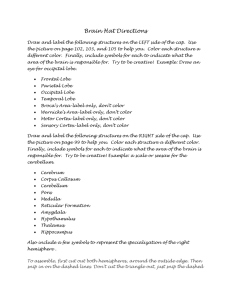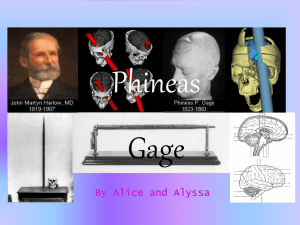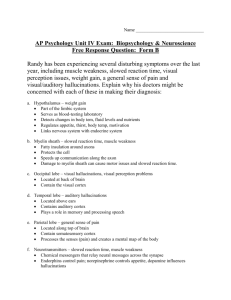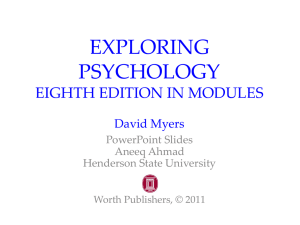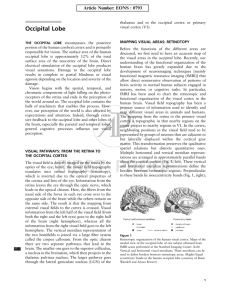Term Test 1 - University of Toronto Mississauga
advertisement
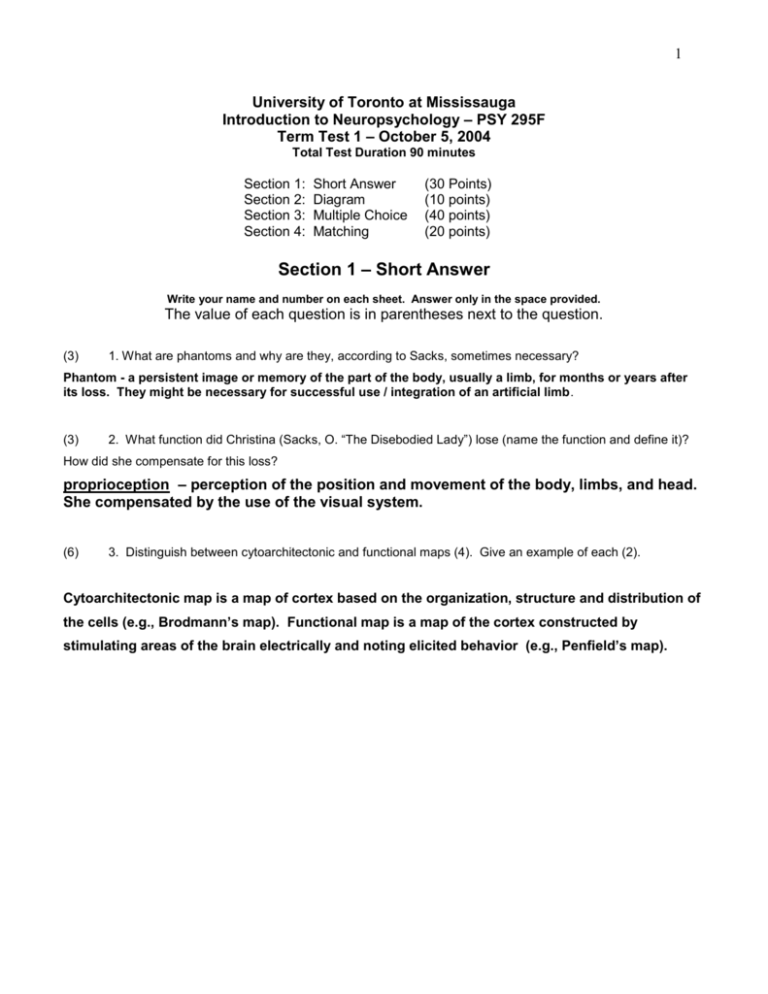
1 University of Toronto at Mississauga Introduction to Neuropsychology – PSY 295F Term Test 1 – October 5, 2004 Total Test Duration 90 minutes Section 1: Section 2: Section 3: Section 4: Short Answer Diagram Multiple Choice Matching (30 Points) (10 points) (40 points) (20 points) Section 1 – Short Answer Write your name and number on each sheet. Answer only in the space provided. The value of each question is in parentheses next to the question. (3) 1. What are phantoms and why are they, according to Sacks, sometimes necessary? Phantom - a persistent image or memory of the part of the body, usually a limb, for months or years after its loss. They might be necessary for successful use / integration of an artificial limb. (3) 2. What function did Christina (Sacks, O. “The Disebodied Lady”) lose (name the function and define it)? How did she compensate for this loss? proprioception – perception of the position and movement of the body, limbs, and head. She compensated by the use of the visual system. (6) 3. Distinguish between cytoarchitectonic and functional maps (4). Give an example of each (2). Cytoarchitectonic map is a map of cortex based on the organization, structure and distribution of the cells (e.g., Brodmann’s map). Functional map is a map of the cortex constructed by stimulating areas of the brain electrically and noting elicited behavior (e.g., Penfield’s map). 2 (4) 4. Suppose you are a neuropsychologist that does not know which part of the brain is necessary for language comprehension. Having an fMRI scanner at your disposal, describe, in general, how you would go about finding this language comprehension area in the brain. Test subjects in fMRI scanner listening to speech – see which parts of the brain are activated. For control condition, have subjects listen to noise (matching speech in intensity etc., presented in experimental condition). See which parts of the brain are activated. Subtract the brain activation in the control condition from the activation in the experimental (comprehension) condition. (3) 5. Two major language processes are that of production and comprehension. Your fMRI scan has indicated that area “X” is activated when an individual is comprehending language. However, this is only a single dissociation. What kind of additional fMRI evidence do you need in order to show that language comprehension and language production are truly dissociable from one another? You need a double dissociation. You need to show that language production is associated with activation in some other area but not the comprehension area (“x”). Have subjects produce language – look at brain activation. In the control condition have the subjects produce random words or some kind of sound. (3) 6. The three major parts of the telencephalon are: a. Cortex / neocortex (1) b. Basal Ganglia c. Limbic System 7. What are the advantages to data gathered via single-cell recording? Good resolution (1) 8. What are the disadvantages to data gathered via single-cell recording? Low generalizability (2) 9. According to Sternberg’s (1975) experiment, how is information processed? Serially; self-exhaustive 3 (2) 10. Describe a cortical column or module. hypothetical unit of cortical organization believed to represent a vertically organized intracortical connectivity that is assumed to correspond to a single functional unit (2) 11. What is meant by the “binding problem” in neuropsychology? Theoretical problem with the integration of sensory information. Because a single sensory event is analyzed by multiple parallel channels that do not converge on a single region, there is said to be a problem of binding together the segregated analyses into a single sensory experience. 4 Section 2 – Diagram (10) On the appropriate figure bellow, label each structure by clearly placing the corresponding number on the appropriate structure: 1) Pons 2) Primary somatosensory cortex 3) Central fissure 4) Corpus callosum 5) Lateral fissure 6) Primary motor cortex 7) Broca’s area 8) Cingulate cortex 9) Pituitary 10) Occipital cortex Sections 1 & 2 (Short Answer & Diagram): _______ Sections 3 & 4 (Short Answer and Matching): _______ Total: _______% 5 University of Toronto at Mississauga Introduction to Neuropsychology – PSY 295F Term Test 1 – October 5, 2004 Section 3 – Multiple Choice (40 points) Answer on the Scantron Sheet FORM A 6 1. Descartes was an articulate proponent of what position? A. interactive monism B. dualism C. the cardiac hypothesis D. non-materialism 2. The currently used term “distributed function” is closest in meaning to which term? A. hierarchical organization B. conduction aphasia C. localization of function D. Hebbian synapse 3. What is the name of the philosophical position that language and behavior can be accounted for by understanding brain function? A. mentalism. B. brain theory. C. materialism. D. dualism 4. Where is Broca’s area located? A. posterior frontal lobe B. dorsal temporal lobe C. anterior temporal lobe D. medial occipital lobe 5. Where is Wernicke’s area located? A. temporal lobe B. posterior frontal lobe C. medial occipital lobe D. limbic lobe E. dorsal parietal lobe 6. What is the name of supporting cells in the nervous system? A. neuroblasts B. germinal cells C. glial cells D. reticular matter cells 7. Where is the cortex located? A. Diencephalon B. Telencephalon C. Myelencephalon D. Metencephalon 8. What secretes the cerebral spinal fluid into the ventricles? A. pineal body B. ependymal cells C. epithalamus D. astrocytes 9. How many lobes is the cortex divided into? A. three lobes. B. four lobes. C. five lobes. D. six lobes. 7 10. Following a stroke, Mr. A has experienced loss of visual functions. Which artery has been affected? A. the anterior cerebral artery B. the medial cerebral artery C. the inferior cerebral artery D. the posterior cerebral artery 11. What is caudate nucleus part of? A. the basal ganglia. B. the limbic system. C. the olfactory system. D. the hindbrain. 12. What are dermatomes associated with? A. the internal nervous system. B. the spinal nervous system. C. the autonomic nervous system. D. the cranial nervous system. 13. What is the ventral portion of a structure sometimes called? A. superior. B. inferior. C. dorsal. D. medial. 14. Awaking from sleep is a function of: A. the pons. B. the medulla. C. the cerebellum. D. the reticular formation. 15. The superior and inferior colliculi have what respective functions? A. auditory and visual B. visual and auditory C. tactile and visual D. visual and tactile 16. Sexual behavior is a primary function of: A. the thalamus. B. the hypothalamus. C. the gyrus fornicutus. D. the red nucleus. 17. Which of the following is not part of the forebrain? A. cortex B. tectum C. basal ganglia D. limbic system 18. What is the name of the single cell from which the brain of the embryo originates? A. blast cell B. neuron C. mother cell D. stem cell 19. What term explains the concept that the dorsal portion of the spinal cord is sensory in function while the ventral portion is motor? A. parallel processing B. dermatomal arrangement C. bilateral symmetry D. Bell-Megendie law 8 20. What is the name of ridges in the neocortex? A. meninges B. sulci C. fissures D. gyri 21. Which are cortical output layers? A. V and VI B. I, II and III C. I and IV D. II and III 22. Which of the following is an interhemispheric commissure? A. anterior commissure B. cingulum C. uncinate tract D. all of the above 23. What is the outermost layer of brain covering? A. pia matter B. meningeal layer C. dura mater D. arachnoid layer 24. What is the name of an animal in which only the hindbrain and spinal cord remain? A. decorticate B. low decerebrate C. high decerebrate D. diencephalic 25. Where is the lowest level of neural tissue necessary for the production of voluntary movements? A. diencephalon B. spinal cord C. neocortex D. midbrain 26. According to Luria’s formulations, what lobe comprises the motor unit? A. temporal B. parietal C. frontal D. occipital 27. Where is the basic neural circuitry for walking located? A. spinal cord B. cerebellum C. basal ganglia D. primary motor cortex 28. According to Luria’s formulations, what lobe(s) comprises the sensory unit? A. temporal B. parietal C. frontal D. occipital E. a, b and d 9 29. Which of the following cannot be done by a low decerebrate preparation? A. tail lashing B. walking C. thermoregulation D. hissing 30. What is the name of the condition characterized by excessive tone in the antigravity muscles? A. decerebrate rigidity B. decorticate rigidity C. narcolepsy D. ahomeostassis E. brain-injury stiffness 31. Which of the following is beyond the capacity of a decorticate rat? A. temperature regulation B. find food and water C. show normal sleep-wake cycles D. none of the above E. a, b and c 32. Which of the following is the most accurate measure of brain structure and function? A. PET B. TMS C. CT D. fMRI 33. What can dynamic imaging technology record? A. changes in brain activity B. glucose consumption C. local blood flow D. all of the above 34. The basis for many dynamic imaging systems is that active brain regions_____________. A. are warmer than less active brain regions B. import more blood than less active regions C. have more dendrites than less active regions D. all of the above 35. ERPs are brief changes in what? A. glucose consumption B. magnetic field C. EEG signal D. X-ray absorption 36. What does CT imaging rely on? A. magnetic reorientation of hydrogen molecules B. electrical activity of the brain C. magnetic field produced by action potentials D. x-rays E. none of the above 37. If someone was in a car accident, what imaging tool could be used to assess the location of large brain damage? A. CT scan B. MRI scan C. Angiogram D. EEG E. A and B 10 38. If someone is suspected of having a problem with the brain’s vascular system (e.g., an aneurysm), what imaging tool could be used to asses this problem? A. MEG scan B. PET scan C. Angiogram D. EEG E. A and D 39. If you wanted to assess which part of the brain was active when someone is producing language what imaging tool could you use? A. CT scan B. fMRI scan C. Angiogram D. PET scan E. B and D 40. What is the likely firing rate for human cortical neurons? A. 300-400 discharges per minute B. 75-100 discharges per minute C. 150-200 discharges per minute D. 3-10 discharges per minute 11 University of Toronto at Mississauga Introduction to Neuropsychology PSY 295F Term Test 1 – Oct. 5, 2004 Section 4 – Matching (20 points) Answer on the Scantron Sheet 41- 44. The history of neuropsychology has been influenced by a variety of hypotheses regarding the functional organization of the human brain. For each hypothesis choose the individual most closely associated with the idea from the list on the right. 41. Antilocalization D A. Golgi 42. Hierarchical organization C B. Ramon y Cajal 43. Nerve net hypothesis A C. Hughlings-Jackson 44. Neuron hypothesis B D. Goltz 45-48. Match the method in each question with the correct alternative. 45. PET scans B A. can detect neurotransmitter molecules 46. MRI D B. annihilation events 47. MRS A C. useful to find epileptic discharge source 48. MEG C D. spinning hydrogen ions 49-52. Match the item in each question with the correct alternative: 49. Alpha rhythm B A. aroused state 50. Beta rhythm A B. relaxed state 51. Delta rhythm D C. eye movements 52. EOG C D. sleep 53-56. Match the item in each question with the correct alternative: 53. Front A A. anterior 54. Ipsilateral D B. posterior 55. Contralateral C C. on the opposite side 56. Back B D. on the same side 57-60. Match the item in each question with the correct alternative: 57. Bottom D A. carries messages toward a given structure 58. Efferent C B. dorsal 59. Afferent A C. carries messages from a given structure 60. Top B D. ventral




